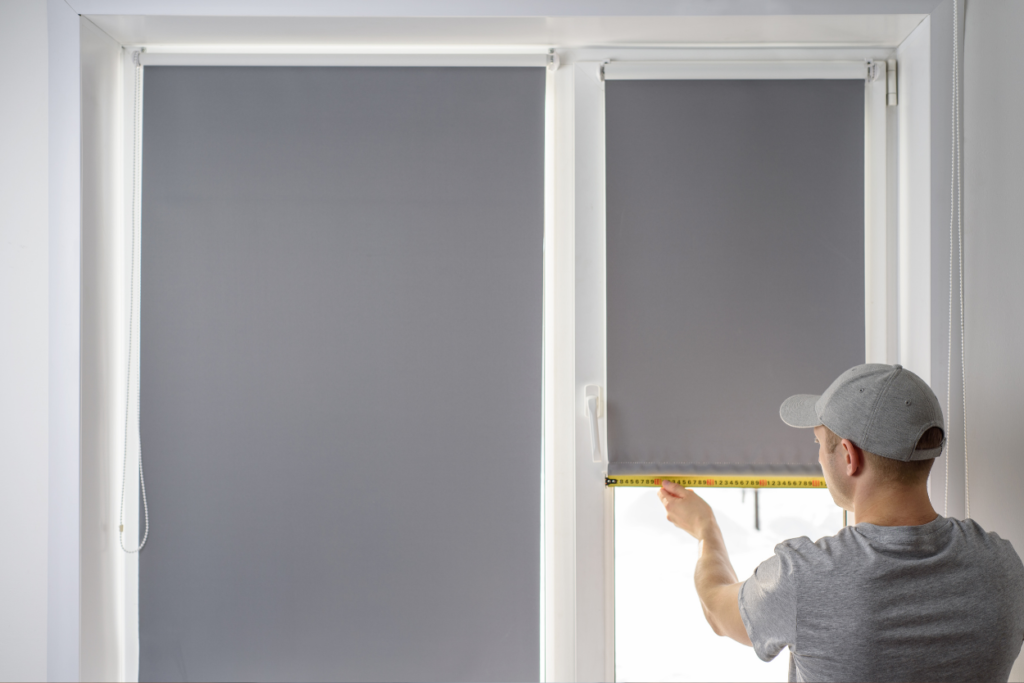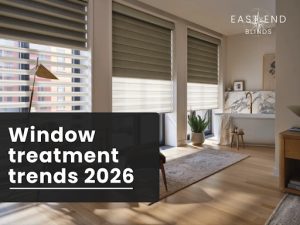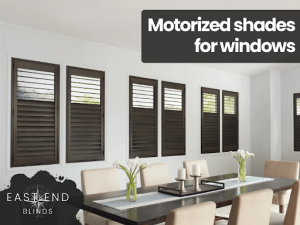
Vertical blinds are a practical and stylish option for any room, offering privacy, light control, and a sleek design. But did you know you can elevate their look and efficiency with creative layering techniques? Whether you’re aiming for a modern look or increased insulation, these ideas will help you make the most of your vertical blinds installation in Bethpage, NY.
Table of Contents
Key Takeaways |
✔ Combining sheer curtains with vertical blinds adds softness and enhances light control.
✔ Pairing blackout curtains with vertical blinds provides maximum privacy and energy efficiency.
✔ Layering Roman shades with vertical blinds offers a sophisticated, customizable look.
✔ Adding a valance or cornice to vertical blinds creates a polished and cohesive appearance.
✔ Framing vertical blinds with decorative drapes adds a stylish accent while maintaining functionality.
✔ Layering window films with vertical blinds improves energy efficiency, privacy, and UV protection.
6 Creative Layering Ideas for Stylish and Efficient Vertical Blinds
Idea 1: Sheer Curtains + Vertical Blinds
When it comes to enhancing your home décor, layering sheer curtains with vertical blinds combines style and practicality. Sheer curtains have an element of softness and elegance, while the vertical blinds ensure functional light control.
Why Choose Sheer Curtains and Vertical Blinds
The combination of sheer curtains and vertical blinds is perfect for those who want a modern look without sacrificing functionality. While sheer curtains add an airy, light feel to the room, vertical blinds installation helps with:
- Light Control: Vertical blinds allow you to easily adjust the amount of light entering the room.
- Privacy: You can maintain privacy without completely blocking out sunlight.
- Efficiency: Vertical blinds are easy to operate and are a great solution for larger windows or sliding doors..
- Easy to Maintain: Both sheer curtains and vertical blinds are low maintenance. Simply wipe down the blinds and wash the curtains occasionally to keep them looking fresh.
- Layering for All Seasons: During the day, enjoy the breezy, light feel of sheer curtains while the blinds manage light and heat. In the evening, close the vertical blinds for privacy and comfort.
- Light Control: Vertical blinds allow you to easily adjust the amount of light entering the room.
How to Layer Sheer Curtains with Vertical Blinds
Layering sheer curtains with vertical blinds installation is simple. Here’s how to do it right.
- Choose the Right Sheer Fabric: Opt for light, breathable fabrics like linen or chiffon. Neutral tones like white, beige, or pastel shades enhance the airy feel.
- Select Complementary Vertical Blinds: For a cohesive look, choose vertical blinds in a color that complements your sheer curtains. Consider materials like vinyl or fabric for durability and design cohesion.
- Install Vertical Blinds Correctly: Ensure that the vertical blinds installation is precise and allows the blinds to move freely behind the sheer curtains. Install a double curtain rod or track system to support both window treatments.
- Achieve the Perfect Look: Allow the sheer curtains to softly drape in front of the blinds for a layered, elegant appearance. Keep the vertical blinds slightly open to filter in natural light while maintaining privacy.
Idea 2: Blackout Curtains + Vertical Blinds
Combining blackout curtains with vertical blinds installation is a versatile layering approach that not only elevates the style of your space but also serves a highly functional purpose.
Why Combine Blackout Curtains with Vertical Blinds
Combining blackout curtains with vertical blinds installation enhances both style and efficiency in any room. Here are a few reasons why pairing these two window treatments can elevate your space.
- Complete Light Blockage: Blackout curtains are perfect for bedrooms, nurseries, or home theaters, where you need absolute darkness. Combined with vertical blinds, you get dual control over natural light, adjusting blinds when needed and pulling curtains for total darkness.
- Enhanced Privacy: Vertical blinds allow you to control visibility from outside, but adding blackout curtains offers a layer of privacy that prevents even the slightest peeking in. This is useful especially at night when the lights are on inside.
- Energy Efficiency: One of the standout advantages of this combination is energy savings. Blackout curtains act as an extra barrier, trapping heat during the winter and keeping your home cool during the summer. Paired with the insulating
capabilities of vertical blinds, this can reduce your energy bills significantly. - Noise Reduction: Blackout curtains also help with soundproofing by blocking outside noise. If you live in a noisy neighborhood or near a busy road, combining blackout curtains with vertical blinds installation can create a quieter, more peaceful environment.
How to Layer Blackout Curtains and Vertical Blinds
To effectively combine blackout curtains and vertical blinds installation, follow these simple steps:
- Choose the Right Vertical Blinds: During your vertical blinds installation, select blinds that complement the style of your room. Neutral colors work well for a sleek, modern look, while textured or patterned blinds can add depth.
- Select the Perfect Blackout Curtains: Opt for blackout curtains that align with the overall aesthetic of the room. Dark, rich colors can create a dramatic effect, while lighter shades offer a more subtle touch.
- Install a Double Curtain Rod or Track: To layer blackout curtains over your vertical blinds, install a double curtain rod or track system. This allows you to hang the curtains on the outer rod while the vertical blinds remain inside, giving you full control over light and privacy.
- Coordinate the Length and Width: Ensure the blackout curtains are wide and long enough to fully cover the blinds when drawn. Floor-length curtains create a seamless look and enhance insulation.
- Choose the Right Vertical Blinds: During your vertical blinds installation, select blinds that complement the style of your room. Neutral colors work well for a sleek, modern look, while textured or patterned blinds can add depth.

Idea 3: Roman Shades + Vertical Blinds
Pairing Roman shades with vertical blinds installation creates a sophisticated, tailored look for your home. This combination not only offers a unique visual appeal but also provides practical benefits like superior light control and design flexibility.
Why Pair Roman Shades with Vertical Blinds
Vertical blinds offer practical light control but can feel stark. Roman shades add softness and elegance, creating a balanced look.
- Boost Design Flexibility: Roman shades offer endless fabric options and styles, adding texture and warmth. The sleekness of vertical blinds paired with the softness of Roman shades creates a well-rounded aesthetic.
- Maximize Light Control: Vertical blinds installation manage light and glare, while Roman shades add extra privacy. Open the shades during the day for natural light, and close both for complete privacy at night.
- Boost Design Flexibility: Roman shades offer endless fabric options and styles, adding texture and warmth. The sleekness of vertical blinds paired with the softness of Roman shades creates a well-rounded aesthetic.
How to Layer Roman Shades with Vertical Blinds
Layering Roman shades with vertical blinds installation is simple when following the right steps. Here’s how to do it effectively:
- Ensure Proper Vertical Blinds Installation: Begin with proper vertical blinds installation. Ensure the blinds are securely fitted, with smooth operation for optimal functionality.
- Choose Complementary Roman Shades: Select Roman shades that complement the color palette and texture of your room. Ensure the shades are easy to operate and fit the window dimensions perfectly.
- Install Roman Shades: Install Roman shades above or within the window frame, depending on the look you prefer. Make sure the shades can be raised or lowered without interfering with the vertical blinds.
- Ensure Proper Vertical Blinds Installation: Begin with proper vertical blinds installation. Ensure the blinds are securely fitted, with smooth operation for optimal functionality.
Idea 4: Valances or Cornices + Vertical Blinds
When it comes to vertical blinds installation, many homeowners overlook the aesthetic potential of pairing blinds with a valance or cornice. If you’re aiming for a modern or traditional look, this pairing can elevate the overall design of your space.
What Are Valances and Cornices?
Valances and cornices are decorative window treatments that add elegance to any room while concealing curtain hardware. While both serve a similar purpose, they offer distinct design elements that can enhance your space in different ways.
- Valances: Soft fabric coverings that hang over the top of the window, often used to hide curtain rods or blind mechanisms.
- Cornices: Sturdier, often wood-based, box-like structures that frame the top of the window, offering a more architectural or formal feel.
- Valances: Soft fabric coverings that hang over the top of the window, often used to hide curtain rods or blind mechanisms.
Why Add a Valance or Cornice
Including a valance or cornice to your vertical blinds installation provides several design and functional benefits:
- Polished, Cohesive Look: Valances and cornices hide the hardware and headrail of the blinds, creating a cleaner, more polished finish. They can be matched to your room’s decor for a seamless design.
- Enhanced Style Options: Choose from a wide range of fabrics, colors, and designs for valances to suit your room’s aesthetic. Cornices offer a more formal, structured look, ideal for traditional or luxurious interiors.
- Customization: Whether you’re opting for a minimalist valance or an ornate cornice, these features can be customized to fit your unique style. You can even pair them with other window treatments for a layered, dimensional effect.
- Polished, Cohesive Look: Valances and cornices hide the hardware and headrail of the blinds, creating a cleaner, more polished finish. They can be matched to your room’s decor for a seamless design.
How to Install Valances and Cornices with Vertical Blinds
When installing valances or cornices with vertical blinds, here are some helpful tips to ensure everything looks perfect:
- Measure Precisely: Ensure that the valance or cornice is wide enough to cover the entire window and the vertical blind headrail.
- Mounting: Cornices are typically mounted above the window frame, while valances can either be hung from a rod or mounted directly onto the window.
- Coordination: Match the material and color of the valance or cornice to complement both the blinds and the room’s decor.
- Measure Precisely: Ensure that the valance or cornice is wide enough to cover the entire window and the vertical blind headrail.
Idea 5: Decorative Drapes + Vertical Blinds
Pairing decorative drapes with vertical blinds installation can transform a simple space into a sophisticated one. By using drapes to frame your blinds, you can elevate the look of any room without compromising on the practicality that vertical blinds offer.
Why Layer Decorative Drapes with Vertical Blinds
Layering decorative drapes with vertical blinds combines style and function, offering the best of both worlds. Here’s how:
- Enhanced Light Control: Vertical blinds allow you to adjust the amount of natural light, while drapes can block out or soften light as needed.
- Increased Privacy: The combination provides an extra layer of privacy, ideal for rooms that face busy streets or neighbors.
- Improved Insulation: Drapes add an extra layer that helps with temperature regulation, keeping rooms warmer in winter and cooler in summer.
- Stylish Contrast: Blinds provide a sleek, modern look, while drapes bring texture and warmth, creating a balanced design.
- Noise Reduction: The layered fabrics help absorb sound, making the space quieter and more comfortable.
- Enhanced Light Control: Vertical blinds allow you to adjust the amount of natural light, while drapes can block out or soften light as needed.
How to Layer Decorative Drapes and Vertical Blinds
Achieving the perfect look requires attention to detail. Here are a few steps to follow during your vertical blinds installation to make sure everything works harmoniously.
- Install Vertical Blinds First: Ensure that the blinds are securely mounted and functional before adding drapes.
- Choose Drapes That Complement the Blinds:: Select a style, color, or fabric that contrasts or matches your blinds to enhance the overall look. Consider the room’s overall style and purpose when choosing your drapes.
- Room Function: Heavier drapes may work well in bedrooms for added insulation, while lighter, airy fabrics may be better for living areas.
- Color Coordination: Match the drapes to the existing color scheme or create contrast with bold hues.
- Fabric Texture: Silky or linen fabrics add softness, while velvet or wool can bring a more dramatic, cozy feel.
- Install Vertical Blinds First: Ensure that the blinds are securely mounted and functional before adding drapes.
- Mount Drapery Hardware: Position the drapery rod or track slightly above or beyond the edges of the blinds to allow the drapes to frame the window without interfering with the blinds’ movement.
- Ensure Drapes Are the Correct Length: The drapes should just touch the floor or hover slightly above it for a polished look.
- Mount Drapery Hardware: Position the drapery rod or track slightly above or beyond the edges of the blinds to allow the drapes to frame the window without interfering with the blinds’ movement.
Idea 6: Layering with Window Films + Vertical Blinds
Vertical blinds installation can be elevated to a new level by layering with window films. Window films are thin, self-adhesive sheets that can be applied directly to glass surfaces.
Why Layer Window Films with Vertical Blinds
The combination of window films and vertical blinds installation offers a range of advantages. Here’s how this layered approach can enhance your space:
- UV Protection: Window films block harmful UV rays, which can cause fading to your furniture, carpets, and wall art. By installing window films, you protect your interior while still allowing natural light to enter the room.
- Energy Efficiency: When window films are layered with vertical blinds installation, they help regulate the temperature inside your home. The films reduce heat transfer, keeping your home cooler in the summer and warmer in the winter, which can reduce your energy bills in the long run.
- Enhanced Privacy: Certain types of window films, like frosted or tinted options, add an extra layer of privacy to your windows, especially for rooms facing the street or neighboring houses. Combined with vertical blinds, you can customize your privacy level with ease.
- Style and Aesthetic Appeal: Window films come in a wide variety of patterns and textures, from simple frosted designs to intricate decorative motifs. By layering them with vertical blinds, you can enhance the overall look of your windows without sacrificing functionality.
- UV Protection: Window films block harmful UV rays, which can cause fading to your furniture, carpets, and wall art. By installing window films, you protect your interior while still allowing natural light to enter the room.
How to Layer Window Films with Vertical Blinds
Achieving the perfect balance between form and function requires a thoughtful approach to layering window films with vertical blinds installation. Here are a few tips to consider:
- Choose the Right Film: Depending on your needs, select window films that match your desired level of privacy, light control, and aesthetic appeal. For instance, frosted films work well in bathrooms or bedrooms, while clear or lightly tinted films can be ideal for living rooms.
- Complement with the Right Blinds: Pairing your window films with the right style of vertical blinds is key to achieving a cohesive look. For a modern touch, opt for sleek, neutral-colored blinds. For a more traditional feel, choose textured or patterned vertical blinds that complement the design of your films.
- Consider Light Control: While window films offer some light diffusion, vertical blinds give you complete control over how much light enters the room. By adjusting the slats, you can decide whether to let in a soft glow or block out light entirely.
- Choose the Right Film: Depending on your needs, select window films that match your desired level of privacy, light control, and aesthetic appeal. For instance, frosted films work well in bathrooms or bedrooms, while clear or lightly tinted films can be ideal for living rooms.
Frequently Asked Questions
How do I measure vertical blinds?
Accurate measurements are essential for a proper fit. If you’re mounting inside the window frame, measure the width and height of the frame at several points and use the smallest measurement. For outside mounts, measure the width of the window and add at least 3-4 inches on each side for proper coverage. Always double-check your measurements before ordering or cutting the blinds.
How do I maintain and clean vertical blinds after installation?
Vertical blinds can be easily maintained with regular dusting or light vacuuming using a soft brush attachment. For deeper cleaning, remove the vanes and wipe them down with a damp cloth or sponge. Some fabric vanes can be machine-washed, but always check the manufacturer’s care instructions. Regular cleaning will help prevent dust buildup and keep the blinds functioning smoothly over time.
Are vertical blinds good for insulation?
Vertical blinds can provide some insulation, though the level depends on the material used. Fabric or PVC blinds, especially those with thicker slats, can help reduce heat loss during winter and block heat during summer. They act as a barrier between the window and the room, preventing drafts and maintaining a consistent temperature. However, they may not insulate as effectively as some other window treatments like thermal curtains.
Are vertical blinds durable?
Vertical blinds are generally durable, especially those made from materials like PVC or aluminum. Fabric vertical blinds are also long-lasting but may require more frequent cleaning to maintain their appearance. The longevity of the blinds depends on the quality of the material and how well they are maintained. Proper use, along with regular cleaning and avoiding harsh handling, can ensure they last for many years.
How do vertical blinds compare to other window treatments?
Vertical blinds offer distinct advantages over other window treatments like horizontal blinds or curtains, especially for larger windows or doors. They provide more control over light and privacy, as well as a sleek, modern look. However, some may prefer the warmth and softness of curtains or the uniformity of roller shades.

Get Expert Services with Your Vertical Blinds Installation!
At East End Blinds & Window Treatments, we specialize in making window solutions both stylish and functional for your home. Whether you’re looking to layer sheer curtains, blackout options, or window films with vertical blinds, our team can guide you through the perfect installation to suit your needs. With years of experience serving Bethpage, NY, we know how to combine design with efficiency to enhance the comfort and appearance of your home.
Contact us today to schedule your vertical blinds installation in Bethpage, NY, and experience expert service with local knowledge.





